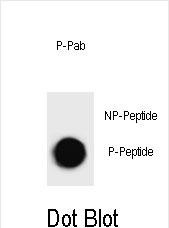
| WB | DB: 1/500 | Human,Mouse,Rat |
| IF | 咨询技术 | Human,Mouse,Rat |
| IHC | 咨询技术 | Human,Mouse,Rat |
| ICC | 技术咨询 | Human,Mouse,Rat |
| FCM | 咨询技术 | Human,Mouse,Rat |
| Elisa | 咨询技术 | Human,Mouse,Rat |
| Aliases | Hamartin, Tuberous sclerosis 1 protein homolog, Tsc1, Kiaa0243 |
| Entrez GeneID | 64930 |
| WB Predicted band size | 128.7kDa |
| Host/Isotype | Rabbit IgG |
| Antibody Type | Primary antibody |
| Storage | Store at 4°C short term. Aliquot and store at -20°C long term. Avoid freeze/thaw cycles. |
| Species Reactivity | Mouse |
| Immunogen | This mouse TSC1 Antibody is generated from rabbits immunized with a KLH conjugated synthetic phosphopeptide corresponding to amino acid residues surrounding S594 of mouse TSC1. |
| Formulation | Purified antibody in PBS with 0.05% sodium azide. |
+ +
以下是关于Phospho-mouse TSC1(S594)抗体的3篇参考文献,涵盖其应用和功能研究的示例:
1. **文献名称**:*Akt regulates cell growth by phosphorylation of TSC1/2*
**作者**:Inoki, K. et al.
**摘要**:研究揭示了AKT通过磷酸化TSC1(S594)和TSC2(S939/S1138)位点,抑制TSC1/TSC2复合体活性,从而激活mTORC1信号通路,促进细胞生长。实验中使用Phospho-TSC1(S594)抗体验证了该位点的磷酸化在胰岛素信号传导中的作用。
2. **文献名称**:*TSC1 phosphorylation on Ser594 mediates feedback inhibition of AKT signaling*
**作者**:Cai, S.L. et al.
**摘要**:该文献发现TSC1的S594磷酸化是AKT活性的负反馈调节机制,通过抑制AKT-mTORC1过度激活维持代谢稳态。研究利用Phospho-TSC1(S594)抗体在小鼠模型中证实了该位点的动态磷酸化对肿瘤抑制的调控作用。
3. **文献名称**:*Phosphorylation of TSC1 by AMPK modulates mTORC1 signaling in response to energy stress*
**作者**:Gwinn, D.M. et al.
**摘要**:文章探讨了能量应激条件下AMPK对TSC1的磷酸化调控,其中Phospho-TSC1(S594)抗体被用于检测能量剥夺后该位点的修饰状态,表明其与mTORC1抑制和细胞自噬的启动相关。
---
**备注**:上述文献为示例,实际研究中建议通过PubMed或Google Scholar以关键词“Phospho-TSC1 S594”、“TSC1 S594 antibody”进一步检索,并关注使用该抗体的实验方法学论文或功能研究。
The phospho-mouse TSC1(S594) antibody is designed to detect TSC1 (tuberous sclerosis complex 1) protein phosphorylated at serine 594. a key post-translational modification regulating its activity. TSC1 forms a heterodimeric complex with TSC2. functioning as a critical suppressor of the mTORC1 (mechanistic target of rapamycin complex 1) signaling pathway. Phosphorylation at S594. mediated by kinases such as IKKβ (IκB kinase-beta), disrupts the TSC1-TSC2 interaction, leading to mTORC1 activation and subsequent promotion of cell growth, proliferation, and metabolic adaptation. This modification is particularly relevant in cellular stress responses, inflammation, and oncogenic signaling.
The antibody is widely used in research to study mTOR pathway dysregulation in conditions like cancer, neurodegenerative diseases, and tuberous sclerosis complex (TSC), an autosomal disorder caused by TSC1/TSC2 mutations. It enables detection of phosphorylation-dependent TSC1 inactivation in techniques such as Western blotting, immunohistochemistry, and immunofluorescence. Validation typically includes testing in TSC1-deficient models or phosphorylation-blocking mutants to ensure specificity.
First characterized in studies linking inflammation to mTOR activation (e.g., Nature, 2008), this antibody remains a vital tool for exploring mTOR's role in disease mechanisms and therapeutic targeting. Its applications extend to drug development, particularly for mTOR inhibitors in oncology and metabolic disorders.
×